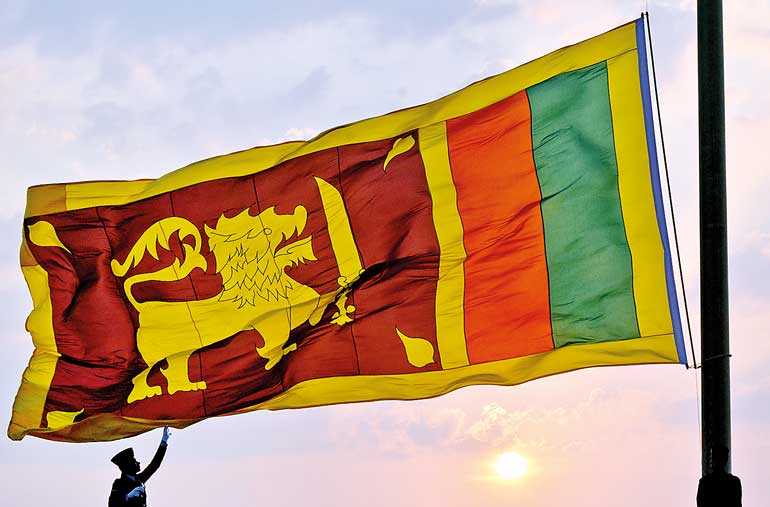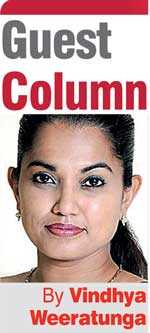Saturday Apr 05, 2025
Saturday Apr 05, 2025
Thursday, 16 January 2020 00:00 - - {{hitsCtrl.values.hits}}

We have one National Flag that is the epitome of inclusion; the orange stripe representing the Tamils and green stripe representing the Muslims. In the same manner, let us include our Tamil speaking brothers and sisters in our National Anthem – Pic by Shehan Gunasekara
The national anthem of a country is considered a national symbol, which is intended to unify a group of people. The language used in an anthem is meant to evoke emotions of belongingness, national identification, and group membership.
The psychological effect of the national anthem on its citizens cannot be undermined. This is why most countries in the world spend years constructing an anthem and why some countries keep changing the lyrics of the anthem to align with the country’s values. Russia is the best example for this, with numerous changes made to the anthem throughout the years.
Sri Lanka’s National Anthem: From past to present
Sri Lanka’s National Anthem was composed by Ananda Samarakoon, a renowned lyricist, music composer, singer and painter. Professor Sunil Ariyaratne, in his book ‘Ananda Samarakoon Adyanaya’ (Ananda Samarakoon – A Critical Study), describes the journey of Ananda Samarakoon and our National Anthem.
Samarakoon studied at the Visva-Bharati University at Shantiniketan, founded by the Nobel Laureate, Rabindranath Tagore, in West Bengal, India. The original version, Namo Matha, was composed by Samarakoon in the year 1940 and was a popular patriotic song at the time. It was performed at the first Independence Day celebrations of the country in 1949. It is interesting to note that the song was translated to Tamil by Pandit M. Nallathambi, which was also performed at the same occasion. However, these were referred to as “National Songs” and not as national anthems in the commemoration notice printed by the Ceylon Government Press. It was only in 1951 that the same song Namo Namo Matha was officially adopted as the National Anthem of our country. 
The struggles of the National Anthem of our country starts here. Critiques of the anthem argued that the gana (the arrangement of the first three syllables) of the introductory words of the anthem were inauspicious and claimed that the tragedies faced by the country, including the deaths of two Prime Ministers: D.S. Senanayake and S.W.R.D. Bandaranaike, were a result of the introductory words Namo Namo Matha.
Samarakoon desperately defended his composition but to no avail. In 1960, the Government of Sirimavo Bandaranaike made the decision to change the introductory words of the anthem, from Namo Namo Matha to Sri Lanka Matha and thus, the National Anthem of our country became Sri Lanka Matha. The new National Anthem was sung for the first time at the Independence Day celebrations in 1961.
The changing of words, without his consent, devastated Samarakoon. He conveyed his disappointment and disgust over the matter to the then opposition leader, Dudley Senanayake, in a letter dated 3 March 1962, which was found on his study desk. The distressed Ananda Samarakoon committed suicide by taking an overdose of sleeping tablets and on 5 April 1962, he died, at the age of 51. One may argue that the first true casualty of our National Anthem was the composer himself and that the anthem was cursed from the very beginning!
Present debate
Until 2016, the National Anthem was sung only in Sinhala during State events, although some media reports suggest that the Tamil translation was sung at official events held in the Tamil-speaking regions of the north and east of the country.
The most common argument presented against the anthem being sung in Tamil is the comparison with India’s National Anthem Jana Gana Mana, which is sung only in one language, despite there being 22 languages recognised by the Indian Constitution.
The main point missed in this argument is that the Indian National Anthem represents all citizens of the country by including all bordering states with different ethnic groups in the lyrics; i.e. Punjab, Sindh, Gujarat, Maratha, Dravida, Utkala, Banga.
Another point is that article 343 (1) of the Indian Constitution mentions Hindi as its official language and recognises 22 languages as regional languages. Despite Hindi being the official and most spoken language in India, it is noteworthy that the National Anthem of India was composed in Bengali by Rabindranath Tagore, and is still sung in its unaltered form at official events.
At the Independence Day celebrations of Sri Lanka in 2016, the Tamil version of the Sri Lankan National Anthem was sung for the first time since the singing of the national song in Tamil in 1949. The Sirisena-Wickremesinghe Government may have believed that by singing the National Anthem in Sinhala and Tamil, the country would step towards ethnic reconciliation.
This decision, however, faced mixed reactions with certain groups voicing their displeasure and opposing the singing of the National Anthem in Tamil. Those in support saw this as progress towards ethnic harmony, whilst those who opposed saw this as a bow down to extremism. Now we are faced with the same debate with the Independence Day celebrations approaching and what the Government’s decision should be.
Where do we go from here?
A national anthem has the power to unite or divide a nation. The anthem represents a country’s values, its principles and motives. For example, the former anthem of West Germany was associated with Nazi Germany, and West Germany struggled for years to define a new national anthem. Austria and Canada changed the lyrics of their national anthems to make them more gender inclusive.
If we were to be united as one nation, everyone needs to feel represented by our National Anthem. We very proudly sing, “eka mavakage daru kala…” (we are children of one mother) but are the Tamil-speaking citizens not daruwo (children) of mother Sri Lanka? Why is it that they do not feel it is their anthem? It may be argued that one of the main factors, if not the main factor, is language.
Language is more than a means of communication. As linguists point out language is steeped with customs and traditions. Language connects people with their culture and is a part of their identity. Sri Lanka has two official languages, Sinhala and Tamil. Research reveals that whilst Sinhala is an Indo-Aryan language (to which Sanskrit belongs), Tamil is a Dravidian language. This means that Sinhala and Tamil languages have different roots. Whilst Sinhala is spoken by the majority, Tamil is spoken by approximately 25% of the population in our country (Sri Lankan Tamils, Indian Tamils, and Sri Lankan Muslims). These two languages are elements of our rich heritage and are essentials of our cultural diversity.
Some Sinhala politicians are of the opinion that singing the National Anthem in the two languages would address post-war ethnic reconciliation, whilst the Tamil politicians are of the view that it is a step in the right direction. However, the question remains… how does singing the National Anthem in two different languages bring two ethnic groups together? On the contrary, are we not moving further away from one another by singing the anthem as two separate groups?
As a nation, we need to sing one anthem; one which we ALL sing. For this, both Sinhalese and Tamils need to find the middle path; come to a compromise. This article proposes a plausible solution, that is to sing one verse of the National Anthem in Tamil, whilst the balance is sung in Sinhala. The entire anthem is sung by all Sri Lankans, where the Sinhala-speaking population sing the Tamil verse in addition to the Sinhala verses, and the Tamil-speaking population sing the Sinhala verses in addition to the Tamil verse.
For example, out of the three verses in our National Anthem, the first two verses can be sung in Sinhala and the last verse can be sung in Tamil. Similar compositions can be found in other countries. For example, South Africa’s National Anthem is composed using five of its official languages (Xhosa, Zulu, Sesotho, Afrikaans, and English) and the anthem is sung by everyone, regardless of their native language. One may question the proposition to sing only one verse of the National Anthem in Tamil and two verses in Sinhala. This is not a matter of equality but of equity. To illustrate with an example, when the pot of rice is served among the family members, serving equal portions to the father, mother, and children would be equality. Serving different-sized portions according to the needs of the person; e.g. serving a larger portion to the parent and a smaller serving to the child, would be equity. Sinhala is spoken by the majority of the population and thus, singing majority of the National Anthem in Sinhala would be just and fair; it would be equitable.
Singing one anthem in each other’s languages has the potential to truly unite all people. If we don’t hesitate to speak the colonial language English, why should we hesitate to speak Tamil or Sinhala? Is it because speaking English is advantageous to us but not Tamil or Sinhala? Sinhala and Tamil are the native languages of our brothers and sisters! Does not unity and harmony matter above everything else? We may have to reflect on what truly matters to us.
The time has come to make bold decisions and changes to embrace unity and harmony. This may require us to put our egos and misguided feelings of nationalism aside and work towards changing the national rhetoric that is inclusive of all ethnic groups; if not for us then for our future generations.
Let us be united in our National Anthem. It is after all, “Sri Lanka Matha”, not “Sinhala Matha” or “Tamil Matha”. This change can be made by this present Government that is led by a President who stands for what is right; who came into power to change the things that prevent our country from progressing in the right direction.
The suggestion to sing one verse of the National Anthem in Tamil will no doubt be criticised, but the job of a leader is not to make popular decisions… it is to make the right decisions. Sinhala will continue to remain the language spoken by the majority; we are simply moving forward by reconciling our differences and healing the wounds of separatism. Inclusion and unity is the path to take. We have one National Flag that is the epitome of inclusion; the orange stripe representing the Tamils and green stripe representing the Muslims. In the same manner, let us include our Tamil speaking brothers and sisters in our National Anthem!
A turning point – the choice is ours
Ironically, it appears that fixing the gana of the National Anthem was unable to prevent the tragedies that befell our country, including the assassinations of our political leaders and a three decade old war that killed innocent civilians, regardless of their ethnicity. The changing of the words of the National Anthem killed the very creator of the anthem. Are we going to allow our National Anthem further divide us as a nation or unite us as the children of mother Sri Lanka? We must cease to be divided. The choice is ours and the decision needs to be made now.